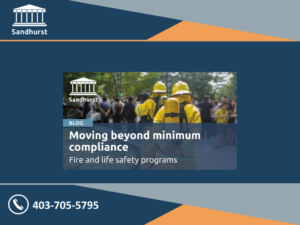When disaster strikes, your front-line personnel are often the first to arrive. Do they know what to do?
Last week, Sandhurst Consulting delivered another successful session of our On-Scene Supervisor course for a long-standing client; a hands-on, scenario-based course designed to equip responders with the skills and confidence to take control in a high-stress, rapidly evolving emergency.

While many organizations focus on training their Incident Management or Emergency Support Teams, they often overlook the critical role of front-line staff. These individuals can make or break the effectiveness of your emergency response. Every organization has unique risks and operations, with high-pressure scenarios such as:
- Medical events
- Traffic accidents
- Loss of containment of hazardous goods
- Pipeline break and spill
- Facility or equipment fire
- High angle rescue
- Well blowout
- Protestors or security events
Training required shouldn’t just be just theory, it should provide an immersive, muscle-memory-building experience that prepares your team to act decisively when seconds count. Think your front-line people are ready to act?
Ask yourself the following questions:
1. Do your people have the skills they need to lead in an emergency?
Whether personnel are expected to take control as an Incident Commander or work as part of a team to stabilize the situation, do they know their accountabilities within the Incident Command System, and do they know what tools will support making informed decisions under pressure?
2. Do they know how and when to escalate?
From initial scene arrival to corporate-level activation, are your front-line staff able to assess the severity of an event and utilize escalation pathways and communication protocols to activate a response? Do they have insight into the unique processes at play when they call for help?

3. Can they assess the scene safely and accurately?
Are your first responders able to properly size-up a scene as it can be the difference between keeping people safe and unintentionally placing them in harm’s way. For this, they must be able to identify hazards prioritize actions and employ tactical decision-making, in critical time sensitive situations?
4. Do they know how to protect themselves and the public?
Whether responders need to evacuate people from an area, identify and establish roadblocks, search an area, or monitor the spread of hazardous materials, they will need to understand and apply the techniques that will keep them and others safe during a chaotic event.

5. Are they prepared to interact with the public?
Emergencies don’t happen in a vacuum. Your front-line responders must have the right training to manage public interactions with professionalism and clarity. Once an event makes it into the media, any missed steps your team took will be in the public domain and can reflect negatively on your company’s reputation.
The Solution:
Consider our On Scene Supervisor Course to strengthen your response. We employ role-players and real tools to simulate an emergency pushing your team to act under pressure with confidence given the right training and tools. Your front-line team deserves to lead with confidence and be successful; it is incumbent on your organization to ensure they are prepared.
Let’s talk about how Sandhurst Consulting can customize training for your organization to mitigate risks and create solid front line capabilities. Contact us today to learn more.




